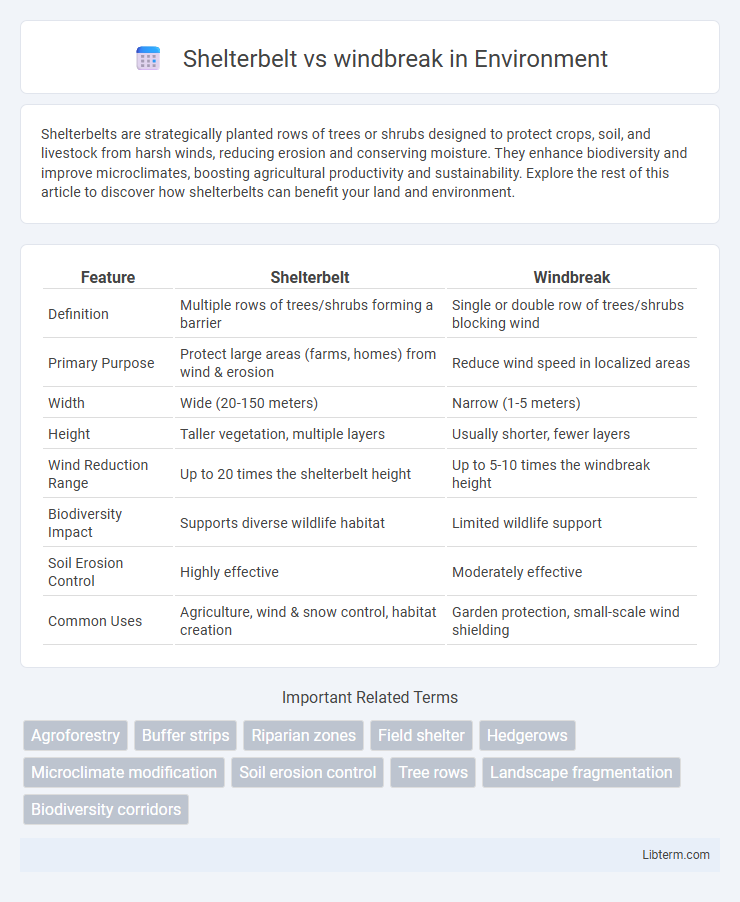Shelterbelts are strategically planted rows of trees or shrubs designed to protect crops, soil, and livestock from harsh winds, reducing erosion and conserving moisture. They enhance biodiversity and improve microclimates, boosting agricultural productivity and sustainability. Explore the rest of this article to discover how shelterbelts can benefit your land and environment.
Table of Comparison
| Feature | Shelterbelt | Windbreak |
|---|---|---|
| Definition | Multiple rows of trees/shrubs forming a barrier | Single or double row of trees/shrubs blocking wind |
| Primary Purpose | Protect large areas (farms, homes) from wind & erosion | Reduce wind speed in localized areas |
| Width | Wide (20-150 meters) | Narrow (1-5 meters) |
| Height | Taller vegetation, multiple layers | Usually shorter, fewer layers |
| Wind Reduction Range | Up to 20 times the shelterbelt height | Up to 5-10 times the windbreak height |
| Biodiversity Impact | Supports diverse wildlife habitat | Limited wildlife support |
| Soil Erosion Control | Highly effective | Moderately effective |
| Common Uses | Agriculture, wind & snow control, habitat creation | Garden protection, small-scale wind shielding |
Understanding Shelterbelts and Windbreaks: Definitions
Shelterbelts and windbreaks are both vegetative barriers designed to reduce wind speed and protect soil, crops, and livestock. Shelterbelts typically consist of multiple rows of trees and shrubs arranged to provide extensive protection over a larger area. Windbreaks are often single or double rows of trees or shrubs primarily aimed at shielding fields or structures from prevailing winds.
Key Differences Between Shelterbelts and Windbreaks
Shelterbelts consist of multiple rows of trees or shrubs designed to reduce wind velocity, protect soil from erosion, and enhance microclimates for crops. Windbreaks typically refer to a single or few rows of vegetation aimed primarily at blocking wind and preventing soil desiccation. Key differences include the scale and density, with shelterbelts providing broader protection through layered vegetation, whereas windbreaks focus on localized wind reduction.
Historical Development of Farm Wind Protection
Shelterbelts and windbreaks both originated as essential agricultural techniques for wind protection, with shelterbelts historically developed through Indigenous practices in North America and later formalized in the 1930s during the Dust Bowl era to combat soil erosion. Windbreaks evolved from simple rows of trees and shrubs strategically planted to reduce wind speed, improving crop yields and livestock comfort. The historical development of farm wind protection reflects advancements in ecological understanding and land management aimed at sustainable agriculture and environmental conservation.
How Shelterbelts Improve Agricultural Productivity
Shelterbelts enhance agricultural productivity by reducing wind speed across crop fields, minimizing soil erosion and moisture loss critical for healthy plant growth. They create a microclimate that lowers evapotranspiration rates, improving water retention and nutrient availability for crops. By acting as buffers, shelterbelts protect plants from damage, leading to increased yields and sustainable farming practices.
Environmental Benefits of Windbreaks
Windbreaks significantly reduce soil erosion by decreasing wind speed and protecting agricultural land from nutrient loss, enhancing crop yields and sustainability. They improve microclimates by moderating temperature extremes and reducing evapotranspiration, which conserves soil moisture crucial for plant growth. Windbreaks also provide habitats for wildlife, promoting biodiversity and contributing to ecosystem stability.
Species Selection for Shelterbelt and Windbreak Design
Species selection for shelterbelt and windbreak design critically influences their effectiveness in reducing wind speed, preventing soil erosion, and supporting biodiversity. Deciduous trees such as poplars and willows are preferred for shelterbelts due to their rapid growth and dense canopy, while evergreens like pines and spruces are favored in windbreaks for year-round protection and wind resistance. Combining diverse native species enhances structural complexity, resilience, and ecological benefits, optimizing microclimate regulation and habitat provision.
Placement and Layout Strategies for Maximum Effectiveness
Shelterbelts are typically planted in multiple parallel rows of trees and shrubs to create a dense barrier, whereas windbreaks often consist of a single or double row of taller trees designed for wind deflection. Optimal placement for shelterbelts involves situating them perpendicular to prevailing wind directions to reduce wind speed over a large area, while windbreaks are strategically located near crops, homes, or livestock areas to provide targeted wind protection. Both require right spacing and staggered planting patterns to maximize airflow control and minimize soil erosion effectively.
Maintenance Considerations for Long-Term Success
Shelterbelts require regular pruning and monitoring to maintain tree health and optimal density, preventing gaps that reduce effectiveness against wind erosion. Windbreaks demand consistent inspection for damage and replanting of dead or diseased plants to ensure continuous wind protection and habitat support. Both systems benefit from soil management practices like mulching and fertilization to sustain plant vigor and long-term environmental benefits.
Climate Adaptation with Shelterbelts vs Windbreaks
Shelterbelts and windbreaks both play crucial roles in climate adaptation by reducing wind speed, preventing soil erosion, and conserving moisture in agricultural landscapes. Shelterbelts, typically consisting of multiple rows of diverse tree species, offer enhanced microclimate regulation and greater protection against extreme weather events compared to single-row windbreaks. Effective use of shelterbelts improves crop resilience, mitigates the impact of drought, and supports sustainable land management in changing climates.
Economic Impact and Cost-Effectiveness Comparison
Shelterbelts and windbreaks both reduce wind erosion and protect crops, but shelterbelts, typically consisting of multiple tree rows, generally provide higher long-term economic benefits through enhanced biodiversity and carbon sequestration. Windbreaks, featuring fewer rows or shrubs, are more cost-effective upfront due to lower planting and maintenance costs but may offer limited protection and economic returns compared to shelterbelts. The choice depends on balancing initial investment against projected increases in crop yields, soil preservation, and ecosystem services.
Shelterbelt Infographic

 libterm.com
libterm.com